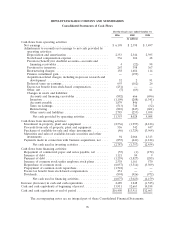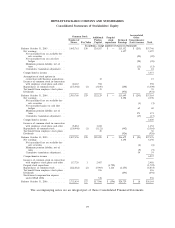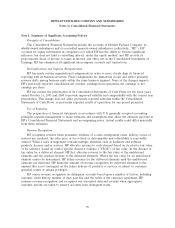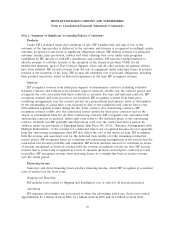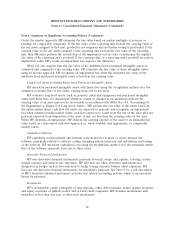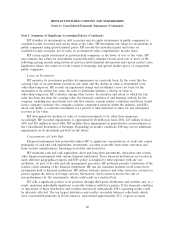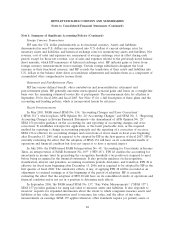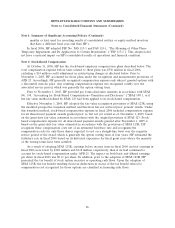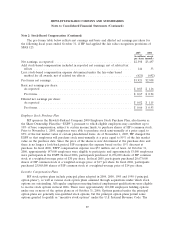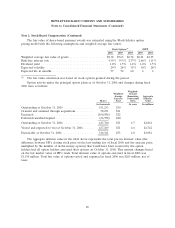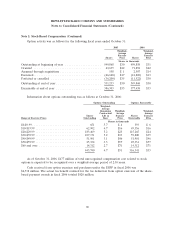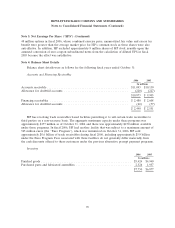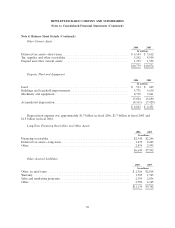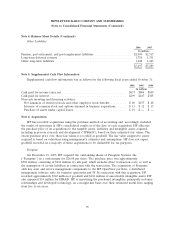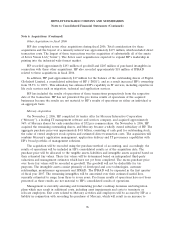HP 2006 Annual Report Download - page 90
Download and view the complete annual report
Please find page 90 of the 2006 HP annual report below. You can navigate through the pages in the report by either clicking on the pages listed below, or by using the keyword search tool below to find specific information within the annual report.HEWLETT-PACKARD COMPANY AND SUBSIDIARIES
Notes to Consolidated Financial Statements (Continued)
Note 1: Summary of Significant Accounting Policies (Continued)
months or less) used for recording results of consolidated entities or equity method investees
that have a different fiscal year end than HP’s.
In fiscal 2006, HP adopted FSP No. FAS 115-1 and FAS 124-1, ‘‘The Meaning of Other-Than-
Temporary Impairment and Its Application to Certain Investments’’ (‘‘FSP 115-1’’). This adoption did
not have a material impact on HP’s consolidated results of operations and financial condition.
Note 2: Stock-Based Compensation
At October 31, 2006, HP has the stock-based employee compensation plans described below. The
total compensation expense before taxes related to these plans was $536 million in fiscal 2006,
excluding a $14 million credit adjustment in restructuring charges as disclosed below. Prior to
November 1, 2005, HP accounted for those plans under the recognition and measurement provisions of
APB 25. Accordingly, HP generally recognized compensation expense only when it granted options with
a discounted exercise price. Any resulting compensation expense was recognized ratably over the
associated service period, which was generally the option vesting term.
Prior to November 1, 2005, HP provided pro forma disclosure amounts in accordance with SFAS
No. 148, ‘‘Accounting for Stock-Based Compensation—Transition and Disclosure’’ (‘‘SFAS 148’’), as if
the fair value method defined by SFAS 123 had been applied to its stock-based compensation.
Effective November 1, 2005, HP adopted the fair value recognition provisions of SFAS 123R, using
the modified prospective transition method and therefore has not restated prior periods’ results. Under
this transition method, stock-based compensation expense in fiscal 2006 included compensation expense
for all share-based payment awards granted prior to, but not yet vested as of, November 1, 2005, based
on the grant-date fair value estimated in accordance with the original provisions of SFAS 123. Stock-
based compensation expense for all share-based payment awards granted after November 1, 2005 is
based on the grant-date fair value estimated in accordance with the provisions of SFAS 123R. HP
recognizes these compensation costs net of an estimated forfeiture rate and recognizes the
compensation costs for only those shares expected to vest on a straight-line basis over the requisite
service period of the award, which is generally the option vesting term of four years. HP estimated the
forfeiture rate in fiscal 2006 based on its historical experience for fiscal grant years where the majority
of the vesting terms have been satisfied.
As a result of adopting SFAS 123R, earnings before income taxes in fiscal 2006 and net earnings in
fiscal 2006 were lower by $448 million and $318 million, respectively, than if we had continued to
account for stock-based compensation under APB 25. The impact on both basic and diluted earnings
per share in fiscal 2006 was $0.11 per share. In addition, prior to the adoption of SFAS 123R, HP
presented the tax benefit of stock option exercises as operating cash flows. Upon the adoption of
SFAS 123R, the tax benefit resulting from tax deductions in excess of the tax benefit related to
compensation cost recognized for those options are classified as financing cash flows.
86


